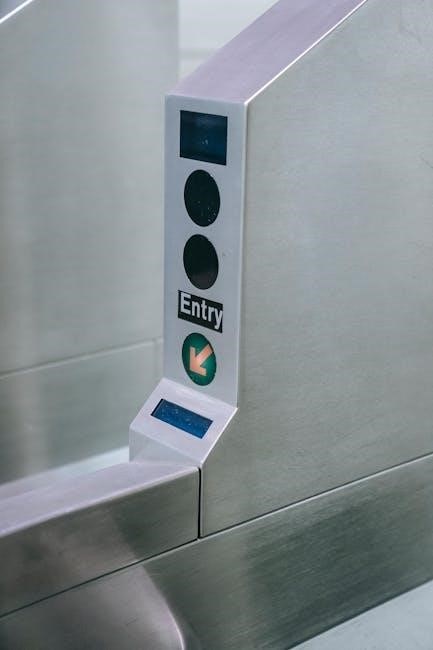An essential guide for deploying, configuring, and troubleshooting wireless networks, access point manuals provide detailed instructions for setting up features, ensuring optimal performance, and maintaining secure connections.
1.1 Overview of Access Points
Wireless access points (APs) are network devices that enable wireless communication between devices and a wired network. They act as central connection points, broadcasting Wi-Fi signals to allow devices like laptops, smartphones, and IoT devices to access the internet. Access points support various Wi-Fi standards, such as 802.11ac and 802.11ax, ensuring high-speed and reliable connections. They can be standalone units or part of a larger network system, offering features like mesh technology for extended coverage and advanced security protocols to protect data.
1.2 Importance of Proper Setup and Configuration
Proper setup and configuration of access points are critical for ensuring optimal network performance, security, and reliability. Incorrect installation can lead to connectivity issues, poor coverage, and vulnerabilities. Configuring settings like channel selection, encryption, and authentication ensures seamless communication and protects data. following the manual’s guidelines helps maximize efficiency, minimize interference, and maintain a stable wireless environment tailored to specific network requirements.
Product Overview and Features
Access points offer advanced wireless connectivity, supporting 802.11ac standards, mesh technology, and quality of service (QoS) settings for high-performance networks. They ensure reliable coverage and scalability.

2.1 Key Features of Wireless Access Points
Wireless access points (APs) support advanced networking with features like 802.11ac, mesh technology, and Quality of Service (QoS) settings. They offer dual-band functionality, ensuring reliable connectivity for multiple devices. Many models include PoE support, reducing the need for additional power sources. Secure authentication methods like WPA3 and seamless roaming capabilities enhance user experience. Scalable solutions cater to small offices and large enterprises, while cloud-based management simplifies configuration. These features ensure optimal performance, security, and ease of setup for diverse networking needs.

2.2 Compatible Models and Hardware Requirements

Wireless access points vary by model, with popular options including UniFi 6, Aruba 310 Series, and D-Link models. Ensure compatibility with your network by checking hardware requirements such as PoE support, Gigabit Ethernet ports, and minimum firmware versions. For example, UniFi APs require a UniFi Controller, while Aruba APs need compatible controllers. Verify compatibility with existing infrastructure to ensure seamless integration and optimal performance.

Installation and Setup Guide
A comprehensive guide covering pre-installation checklists, physical mounting, and initial configuration steps to ensure a smooth setup process for your wireless access point. Tools and best practices for optimal performance and connectivity.
3.1 Pre-Installation Checklist
Before installing your access point, ensure you have all necessary components, including the device, power adapter, Ethernet cables, and mounting hardware. Verify network requirements, such as an available IP address and DHCP settings. Check compatibility with existing hardware and software. Familiarize yourself with the installation environment, including optimal placement for coverage and physical constraints. Review safety guidelines to avoid damage or electrical hazards. Ensure the firmware is up-to-date for optimal performance. Plan the network topology to ensure seamless integration.
3.2 Physical Installation Steps
Mount the access point using the provided bracket, ensuring secure placement on a wall or ceiling. Connect the Ethernet cable to the AP’s port and the other end to your router or network switch. Plug in the power adapter to the AP and a nearby outlet. Ensure all cables are tightly secured to prevent accidental disconnection. Verify the AP powers on and initializes correctly. Check for LED indicators to confirm proper operation before proceeding to configuration.
3.3 Initial Configuration Using Quick Setup Wizard
Access the Quick Setup Wizard through a web browser by typing the AP’s default IP address. Log in using the admin credentials provided in the manual. Follow the wizard to set up basic configurations, such as admin password, network name (SSID), and security settings like WPA3 encryption. Choose the operating mode (e.g., Access Point or Mesh); Save your settings and reboot the device to apply changes. Ensure all configurations align with your network requirements for optimal performance and security.

Network Configuration
Network configuration involves setting up internet connections, customizing wireless settings, and configuring security parameters to ensure a secure, efficient, and scalable wireless network environment.
4.1 Setting Up Internet Connection
To establish a stable internet connection, connect the access point to your router using an Ethernet cable. Ensure the cable is securely plugged into both devices. Open a web browser and log in to the access point’s admin interface. Configure the IP settings, selecting DHCP for automatic IP assignment or setting a static IP if required. Save your settings and restart the device. Test the connection by pinging an external website or accessing online resources.
4.2 Customizing Wireless Network Settings
Customize your wireless network settings by accessing the access point’s admin interface. Set a unique SSID for your network and choose a secure encryption method, such as WPA3. Configure the wireless channel to avoid interference and optimize performance. Define a strong password and enable features like MAC address filtering or guest network access. Save your settings and reboot the device to apply changes. Regularly update firmware to ensure security and functionality.
4.3 Configuring Security Parameters
Enable WPA3 encryption for maximum security and set a strong, unique password. Use MAC address filtering to control device access and disable SSID broadcasting. Configure a firewall to block unauthorized traffic and schedule regular firmware updates. Restrict admin access to specific IP addresses and ensure a secure connection for remote management. Regularly review and update security settings to protect against emerging threats. Always change default passwords and use multi-factor authentication for added layers of protection and network integrity.
Advanced Configuration Options
Explore advanced features like mesh networking, QoS settings, and remote management for enhanced performance and security. Customize settings to meet specific network requirements and optimize connectivity.
5.1 Mesh Technology and Multi-AP Setup
Mesh technology enables seamless wireless coverage by interconnecting multiple access points, ensuring robust and reliable network performance. This setup dynamically optimizes data paths and minimizes signal loss, providing uniform connectivity across large areas. Multi-AP configurations are ideal for expanding networks in offices, homes, or outdoor environments. By integrating mesh capabilities, users can enjoy uninterrupted service, automatic failover, and enhanced scalability, making it a powerful solution for modern networking demands.
5.2 Quality of Service (QoS) Settings
Quality of Service (QoS) settings ensure optimal network performance by prioritizing traffic. Configure QoS to minimize latency and jitter for critical applications like VoIP or video streaming. Assign bandwidth limits and traffic classification to guarantee fair resource allocation. Advanced QoS features allow customization of policies, ensuring seamless operation of mission-critical services. Properly configured QoS enhances user experience and prevents network congestion, making it essential for environments with diverse connectivity demands.

5.3 Remote Management and Cloud-Based Control
Remote management and cloud-based control enable centralized monitoring and configuration of access points through web-based platforms. Platforms like Meraki Dashboard or UniFi Controller allow administrators to manage multiple devices from a single interface. Features include real-time analytics, firmware updates, and custom settings deployment. Cloud-based systems enhance scalability and simplify maintenance, ensuring consistent network performance across locations. Secure remote access ensures that IT teams can troubleshoot and optimize networks efficiently, reducing downtime and improving overall efficiency.

Troubleshooting Common Issues

Identify and resolve connectivity problems, firmware issues, or physical installation errors. Check cables, restart devices, and update firmware to ensure stable network performance and optimal functionality.
6.1 Diagnosing Connectivity Problems
Begin by verifying physical connections, ensuring the access point is powered on and properly linked to the network. Check for loose cables and damaged ports. Restart the device to reset configurations. Use diagnostic tools to assess signal strength and interference levels. Ensure firmware is up-to-date and compatible with connected devices. Review IP settings and subnet masks for accuracy. Consult logs for error messages and perform a network ping test to isolate issues.

6.2 Resolving Configuration Conflicts
To resolve configuration conflicts, start by checking channel settings to avoid interference. Ensure the IP address is correctly assigned, either statically or dynamically. Verify that security protocols match across devices. Update firmware to the latest version to fix bugs. Review firewall rules to allow necessary traffic. Check time settings for synchronization with an NTP server. Finally, restore from a backup if recent changes caused issues. Addressing these areas step-by-step can help restore network stability and performance.
6.3 Best Practices for Maintenance
Regularly update firmware to ensure security and performance. Monitor system logs for potential issues and optimize settings for reliability. Conduct periodic check-ups to ensure optimal signal strength and coverage. Inspect physical connections and hardware for damage or wear. Schedule routine reboots to clear cached data and maintain stability. Document all changes for future reference and troubleshooting. These practices help maintain a robust and efficient wireless network, minimizing downtime and ensuring seamless connectivity.
Access point manuals are vital for effective deployment and maintenance. For further guidance, refer to manufacturer-specific documentation, online forums, and tutorials for tailored solutions and troubleshooting tips.
7.1 Summary of Key Steps
Proper installation and configuration of your access point are essential for optimal performance. Start with a pre-installation checklist, ensuring all hardware and software requirements are met. Follow physical installation steps carefully, positioning the AP for maximum coverage. Use the Quick Setup Wizard for initial configuration, then customize wireless settings and security parameters. Regularly update firmware and perform maintenance checks to ensure reliability. Troubleshoot common issues promptly, and explore advanced features like mesh technology or QoS for enhanced network performance. Refer to the manual for detailed guidance on each step.
7.2 Recommended Reading and Documentation
For comprehensive understanding, refer to the official access point manual and supplementary guides. Explore Quick Start Guides for initial setup and advanced configuration options. Visit manufacturer websites for detailed product-specific documentation, such as Ubiquiti UniFi or TP-Link resources. Additional materials like FAQs, troubleshooting guides, and best practice documents are also available online. These resources ensure you maximize your access point’s potential and resolve issues efficiently.
